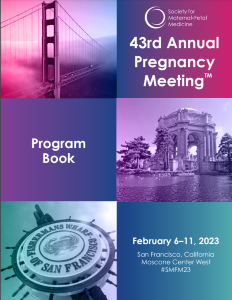Oral Plenary Session II
Oral Plenary Sessions
Livestreamed
12 - A randomized trial of an interactive childbirth education platform in a high-risk population
To compare an interactive online platform for childbirth education (Birthly), to usual prenatal education on anxiety, emergency healthcare utilization, and delivery outcomes for high-risk pregnancies.
Study Design:
We performed a randomized trial comparing an interactive online childbirth education platform along with usual prenatal education (intervention) to usual prenatal education alone. Nulliparous, English-speaking patients with internet access and a high-risk pregnancy (medical or mental health disorders) were included. Patients in 2 urban clinics that serve under-resourced patients were enrolled at < 20 wks. The intervention included 3 interactive courses (prenatal bootcamp, breastfeeding, newborn care) and access to a clinician-moderated online community. Pregnancy-related Anxiety Scale (PrAS) questionnaires were administered at randomization and at 34-40 wks. The primary outcome was 3rd trimester PrAS score. Secondary outcomes included change in PrAS score, unscheduled emergency visits, delivery and postpartum outcomes
Results:
90 patients were randomized with no differences in demographics or baseline PrAS scores (Table 1). The majority of patients self-identified as Black and were publicly insured. Patients in the intervention arm had significantly lower third trimester PrAS scores (indicating lower anxiety) compared to usual care, 44.6 ± 7.3 vs. 53.9 ± 13.8, p< 0.01 (Table 2), with a decrease in PrAS score of 8.3 points (intervention) vs. 0.7 (usual care), p< 0.01. Patients in the intervention arm also had fewer emergency visits (1[0-2] vs. 2[1-3], p=0.003; Table 2). There were no differences in delivery outcomes. Patients in the intervention arm were more likely to breastfeed at delivery, though this was not different by the postpartum visit. Finally, patients who received the intervention were more likely to be satisfied with their childbirth education (94.6% vs. 64.9%, p< 0.01).
Conclusion:
An interactive online childbirth education platform can reduce pregnancy-related anxiety and emergency healthcare utilization while improving satisfaction in a high-risk patient population.

Kelly Zafman, MD, MSCR (she/her/hers)
PGY4, OBGYN Resident
University of Pennsylvania
Philadelphia, Pennsylvania, United States
Kelly Zafman, MD, MSCR (she/her/hers)
PGY4, OBGYN Resident
University of Pennsylvania
Philadelphia, Pennsylvania, United States
Melissa Riegel, MD (she/her/hers)
Resident
University of Pennsylvania
Philadelphia, Pennsylvania, United States
Lisa D. Levine, MD, MSCE (she/her/hers)
Associate Professor
Perelman School of Medicine, University of Pennsylvania
Philadelphia, Pennsylvania, United States
Rebecca F. Hamm, MD,MSCE (she/her/hers)
Assistant Professor of Obstetrics and Gynecology
Department of Obstetrics & Gynecology, Perelman School of Medicine, University of Pennsylvania
Philadelphia, Pennsylvania, United States

.png)
